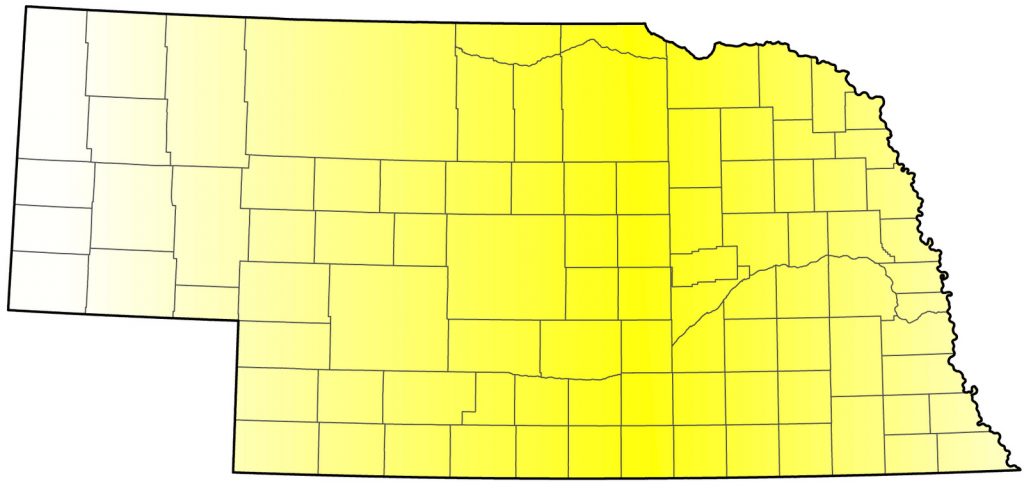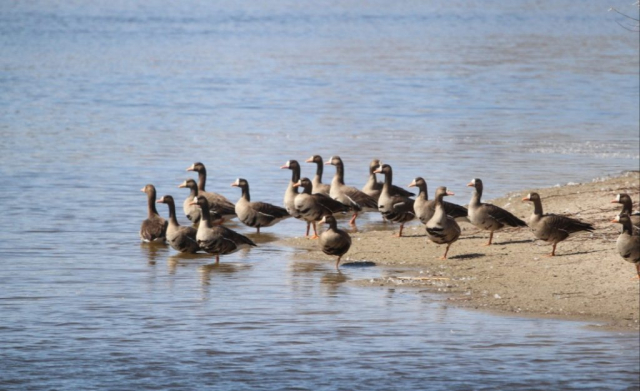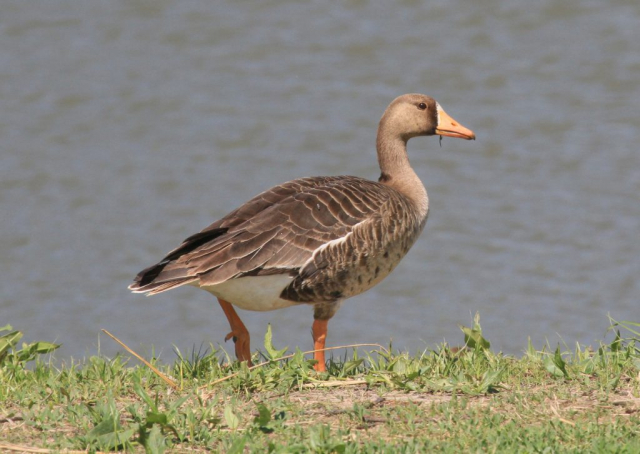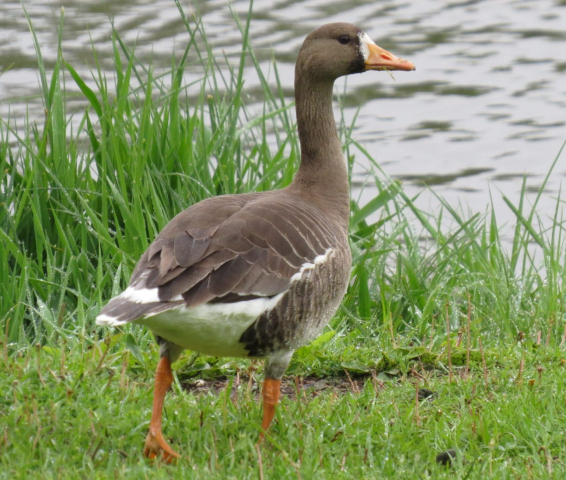Anser albifrons GAMBELLI
Status: Common regular spring and fall migrant central, fairly common east, uncommon west. Rare regular summer visitor south and east, rare casual north and west. Rare regular winter visitor central and east, rare casual west.

Documentation: Specimen: UNSM ZM12412, 1937 or 1938 Lancaster Co.
Taxonomy: Five subspecies are generally recognized, two Eurasian, flavirostris and albifrons, and three North American, discussed below (AviList 2025).
Taxonomy of this species in North America has been in a confused state for some time (Ely et al 2020). The name gambelli is currently in general use for the most numerous subspecies, breeding on Arctic tundra from northeastern Siberia eastward to Hudson Bay and migrating through Nebraska to winter in southeastern Texas and northeastern Mexico (Banks 2011, AviList 2025); more recently the winter range has expanded in the lower Mississippi River region in Arkansas and Louisiana (Mark P. Vrtiska, personal communication). Two other subspecies, elgasi and sponsa occur on the northwestern Pacific Coast (AviList 2025). Pyle (2025) synonymized sponsa with gambelli based on its not meeting the generally accepted 75% rule for subspecies diagnosability.
See “Comments” below for further discussion of names used for North American White-fronted Geese.
Nebraska has records of Greater White-fronted Goose hybrids with Cackling Goose and Canada Goose; see Greater White-fronted x Cackling Goose (hybrid) and Greater White-fronted x Canada Goose (hybrid).
Spring: Jan 24, 25, 26 <<<>>> Apr 17, 17, 18
Early and late dates above include only those reports of >5 individuals, considered migrants.
There are 12 later records of >5 birds through 18 May, best such counts 85 in Dixon Co 24 Apr 2021, 50 over northern Douglas Co 4 May 2019, and 23 over Sarpy Co 27 Apr 2023.
Mid-winter records make it difficult to determine spring arrival dates, but migrants are usually in flocks rather than the singles or very small (family?) groups that occur in winter and summer.
Migration typically begins in late Jan as weather and water conditions allow and continues through mid-Apr, with largest concentrations occurring in early Mar.
- High counts: 100,000 at Funk WPA, Phelps Co 12 Mar 1994, 20,000 in Hall Co 13 Mar 2018, 10,000 at Harvard WPA, Clay Co 28 Feb 2006, 10,000 in Sarpy Co 15 Mar 2019, and 10,000 in Buffalo Co 3 Mar 2023.
Summer: Reports are fewest between late May and late Sep, most of which are injured single birds unable to migrate and, on occasion, their mates. Small summering groups may be family groups with one member unable to migrate, such as the four at Harvard WPA, Clay Co 5 Jul 1995 (Jorgensen 2012). Westernmost reports are from Lake Ogallala, Keith Co, where one was present 12 Jun 2003, another apparently summered in each of 2005, 2013, and 2023, and one was at Oliver Reservoir, Kimball Co 5 Sep 2016.
Fall: Oct 5, 5, 6 <<<>>> Jan 14, 14, 15
Early and late dates above include only those reports of >5 individuals. Migration begins in early Oct and continues into early Jan, with a peak in mid-Oct. There are eight earlier records of >5 birds 5 Aug-5 Oct; quite early were 18 at Alma, Harlan Co 5 Aug 2000, and best early counts 125 on 6 Oct 2014 Lancaster Co and 120 on 6 Oct 2018 Burt Co. See Spring for records 15-24 Jan.
High counts are much lower in fall, as flocks appear to overfly Nebraska during periods of favorable weather (Jorgensen 2012). West of Lincoln Co in the Platte River Valley this species is rare in fall (Rosche 1982, 1994; Brown and Brown 2001); more recently four apparent early migrants were at Lake Minatare, Scotts Bluff Co 30 Sep 2023.
- High counts: 2000 in Lincoln Co 21 Oct 2007, 1800 in Cass Co 29 Oct 2019, 1500 in Richardson Co 15 Oct 2009, 1500 at DeSoto NWR, Washington Co 24 Nov 2018, and 1500 there 24 Nov 2021.
Winter: Individual birds or small groups are sometimes found wintering with flocks of Canada and Cackling Geese. Unusual for the dates, however, were counts of 5000+ in the eastern Rainwater Basin 17 Dec 1998 and 2972 on the DeSoto NWR CBC 19 Dec 2020. Reports are fewest in mid-Jan, with several records of >5 birds 15-24 Jan, most from eastern Nebraska. Best such counts were the 71 at Branched Oak Lake, Lancaster Co 23 Jan 2017, 40 at DeSoto NWR 18 Jan 2021, and 30 at Ritz Lake, Dodge Co 19 Jan 2019. Westerly were 32 at Hansen Reservoir, Lincoln Co 25 Jan 2024.
There are few Panhandle records for mid-winter, although the trend appears to be a slow increase in numbers. A “few” wintered in Scotts Bluff Co 2010-2011, seven were in Scotts Bluff Co 19 Jan 2019, singles were at each of two Scotts Bluff Co locations 18 and 21 Jan 2020, three were at each of two Scotts Bluff Co locations 22 Jan 2021, and up to eight were in Scotts Bluff and Deuel Cos Dec-Feb 2021-2022. Singles were at each of two Scotts Bluff Co locations 5 Dec 2022 and 10 Feb 2023.
Comments: As late as the 1980s, as many as 1,000,000 birds, more than half of the North American White-fronted Goose population, migrated through Nebraska between Arctic breeding grounds and Gulf Coast wintering areas. It was also estimated that up to 90% of the midcontinent population of Greater White-fronted Geese staged in the Rainwater Basin (Gersib et al 1989; LaGrange 2007). Since then, smaller numbers have been observed in central Nebraska and in the Rainwater Basin with larger numbers reported from eastern Nebraska and Iowa, as well as areas west of the Rainwater Basin (Mark P. Vrtiska, NGPC, personal communication). The change in migratory patterns may be in response to a number of variables, including increased numbers of Snow Geese staging in central Nebraska as well as from disturbance from the spring light goose conservation order.
The name gambeli (note spelling) has been used for the larger, darker California birds, known as Tule Goose (Ely et al 2020). In order to remove confusion with the epithet gambelli (note spelling), Delacour and Ripley (1975) replaced gambeli with the subspecific epithet elgasi for Tule Goose. Banks (2011) named a new subspecies, A. a. sponsa, for a population breeding in western Alaska; it does not occur in Nebraska during migration or winter. Banks (2011) retained the name gambelli for the tundra-breeding mid-continent population; this position was followed by AviList (2025). Thus, the three North American taxa are elgasi, sponsa, and gambelli.
However, a case could be made for restricting the name gambelli to the little-known easternmost of the two taiga-breeding populations which breeds on Old Crow River Flats, Yukon, about 175 miles west of the MacKenzie River Delta (Palmer 1976) and using frontalis for the abundant mid-continent tundra-breeding population. Avibase lists the two names as alternatives within the appropriate taxonomic concept (https://avibase.ca/466E9077). We follow AviList (2025) in not accepting this convention; Banks (2011) and Craig Ely (personal communication), believe these MacKenzie River Delta birds to be within the range of variation of gambelli (sensu Banks 2011) and thus not separable from them.
The Tule Goose (elgasi, formerly gambeli but note spelling) is the other, westernmost taiga-breeding population; the two populations use separate breeding, migration, and wintering areas (Palmer 1976) with minimal crossover between flyways (Ely et al 2020).
Occurrence of the taiga-breeding populations has not been documented in Nebraska, although one photographed in Keith Co 13 Jan 2018 (Noah Arthur, Photos) is suggestive; there have been sightings of large, dark (“chocolate-colored”) White-fronted Geese in the North American Interior (Nick Lyman, Martin Reid, personal communication; see link). In addition, band recoveries in Kansas and south-central Texas in the early 1980s of Tule Geese banded in the Pacific Flyway (four out of about 300 birds banded) suggest a crossover of migrants from the Pacific to Central Flyways of about 1% (Craig Ely, personal communication).
Images
Abbreviations
CBC: Christmas Bird Count
NGPC: Nebraska Game and Parks Commission
NWR: National Wildlife Refuge
UNSM: University of Nebraska State Museum
WPA: Waterfowl Production Area (Federal)
Acknowledgement
Mark P. Vrtiska provided access to harvest data and numerous helpful comments that improved this species account.
Literature Cited
AviList Core Team, 2025. AviList: The Global Avian Checklist, v2025. https://doi.org/10.2173/avilist.v2025.
Banks, R. C. 2011. Taxonomy of Greater White-fronted Geese (Aves: Anatidae). Proceedings of the Biological Society of Washington. 124: 226-233.
Brown, C.R., and M.B. Brown. 2001. Birds of the Cedar Point Biological Station. Occasional Papers of the Cedar Point Biological Station, No. 1.
Delacour, J., and S.D. Ripley. 1975. Description of a new subspecies of the White-fronted Goose Anser albifrons. American Museum Novitates 2565.Palmer, R.S., ed. 1976. Handbook of North American birds. Vol. 2. Waterfowl (Parts 1 and 2). Yale University Press, New Haven, Connecticut, USA.
Ely, C.R., A.X. Dzubin, C. Carboneras, G.M. Kirwan, and E.F.J. Garcia. 2020. Greater White-fronted Goose (Anser albifrons), version 1.0. In Birds of the World (S. M. Billerman, Editor). Cornell Lab of Ornithology, Ithaca, NY, USA. https://doi.org/10.2173/bow.gwfgoo.01.
Gersib, R.A., B. Elder, K.F. Dinan, and T.H. Hupf. 1989. Waterfowl values by wetland type within Rainwater Basin wetlands with special emphasis on activity time budget and census data. Nebraska Game and Parks Commission, Lincoln, Nebraska, USA, and U.S. Fish and Wildlife Service, Grand Island, Nebraska, USA.
Jorgensen, J.G. 2012. Birds of the Rainwater Basin, Nebraska. Nebraska Game and Parks Commission, Lincoln, Nebraska, USA.
LaGrange, T. 2007. Guide to Nebraska’s wetlands and their conservation needs. Nebraska Game and Parks Commission, Lincoln, Nebraska, USA.
Palmer, R.S. 1976. Handbook of Norh American Birds. Vol. 2. Waterfowl (Part 1). New Haven, Yale University Press.
Pyle, P. 2025. A Practical Subspecies Taxonomy for North American Birds. North American Birds 76(1).
Rosche, R.C. 1982. Birds of northwestern Nebraska and southwestern South Dakota, an annotated checklist. Cottonwood Press, Crawford, Nebraska, USA.
Rosche, R.C. 1994. Birds of the Lake McConaughy area and the North Platte River valley, Nebraska. Published by the author, Chadron, Nebraska, USA.
Recommended Citation
Silcock, W.R., and J.G. Jorgensen. 2025. Greater White-fronted Goose (Anser albifrons). In Birds of Nebraska — Online. www.BirdsofNebraska.org
Birds of Nebraska – Online
Updated 4 Sep 2025



